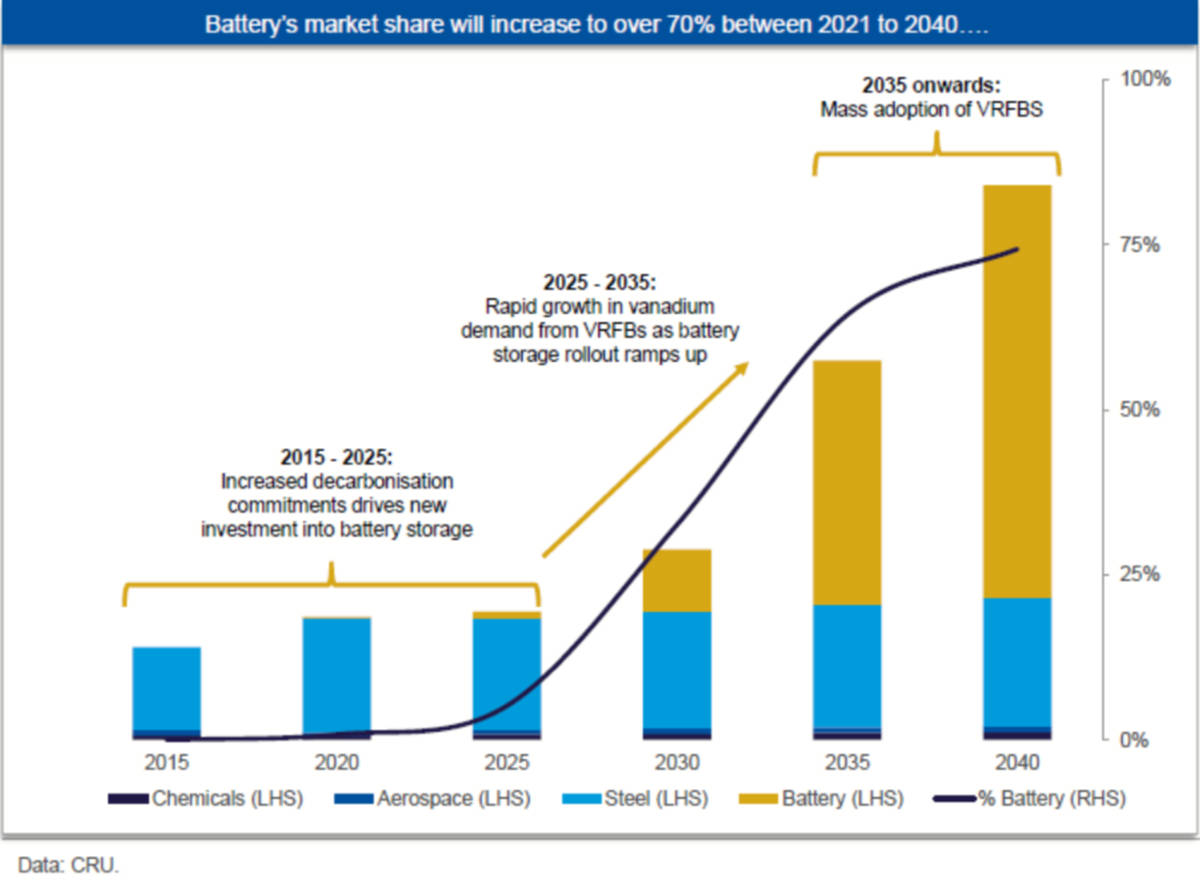Q&A: It’s Technology Metals’ time to shine with vanadium demand set to double by 2032

Pic: Technology Metals/ Stockhead
Vanadium’s bread and butter has traditionally been its use in high strength steel but as the world rushes to decarbonise, market analysts believe its use in safe, low-cost energy storage batteries will soon take over.
With a current market of ~110,000 tonnes in 2022, commodity analysts CRU Group expects vanadium demand to double by 2032, owing more than 90% of this growth to its use in Vanadium Redox Flow Batteries (VRFBs).
VRFBs are used in large scale, battery storage systems that store excess power from the grid for use during peak demand periods.
Whether in combination with solar PV, biogas generators, wind power, or in parallel operation, the bulk storage capacity of these batteries allows consumption to be shifted completely to off-peak hours with cheaper electricity.
As the name suggests, VRFBs use vanadium-ions in the electrolyte solutions and are considered safer, more scalable, and longer lasting than their lithium counterparts with a lifespan of more than 20 years.
Other battery types like lithium-ion or leach-acid are subject to a charging cycle but VRFBs come with vanadium electrolyte storage tanks, which can be replenished even when the system is supplying power.
Vanadium’s bright outlook
CRU Group reckons vanadium demand from batteries will grow from 2.1% in 2021 to 33% in 2030.

By 2040, the battery market’s share of vanadium consumption will climb to more than 70%, placing advanced vanadium stocks like Technology Metals (ASX:TMT) in a prime position to capitalise.
TMT is developing the large-scale, long life Murchison Technology Metals Project (MTMP) in Western Australia’s Midwest region, which will produce 6% of the world’s vanadium when it comes online.
As it stands, Australia has the world’s second largest vanadium reserves and no downstream production capabilities, but TMT is hoping to change that.
The company recently produced high-grade vanadium electrolyte feedstock from the MTMP with its Japanese technology partner, LE System Co.
Moving forward, TMT’s intention is to supply vanadium electrolyte for the deployment of VRFBs in Australia as well as high purity feedstock to electrolyte production facilities across the globe.
Stockhead sat down with TMT’s managing director Ian Prentice to chat about market growth, challenges, and the best way for countries to establish a competitive and sustainable battery industry.
The demand dynamics for vanadium going forward are quite astonishing. From your perspective, is the industry growing above or below predictions?
“The supply side of things is very similar to what is happening in the lithium space – lithium consumers are now really scrambling around to support development of new mines because of that exact problem.
“Vanadium is like all critical minerals and resources projects where it takes about 10 years from discovery to first production – if we find a vanadium project tomorrow, given all the things you need from the technical work, approvals, and Native Title processes, it’s a long journey to get these mines into production.
“Technology Metals is ahead of the curve, we’re on the cusp of going into production but there’s not too many other mines that are similar stage or even that I could see being in production over the next two to five years.
“There’s certainly a challenge for the industry to get projects into development quicker and to fill that space.”
How important is it for governments around the world to support the progress of alternative energy technologies?
“It is important but I think we are seeing it with ARENA and several other government initiatives that are supporting the deployment of larger scale generation capacity, but it has only really been in the last 12 months or so that they’ve started to recognise that storage is key to that.
“Around the world it has been quite different, China has really been at the forefront of these batteries.
“The Chinese Government has been a massive support for rolling out these large batteries for several years now, probably for the last five or six years, so they recognise the benefit there.
“We’re certainly seeing it more and more with the Inflation Reduction Act in the US and there’s also some things happening – the EU Green Deal Industrial Plan announced recently to encourage industrial manufacturing capacity of key technologies such as batteries.
“As the technologies and needs develop, we will continue to see a lot more support in this space.”
What is the best way for countries to establish a competitive and sustainable battery industry?
“Vanadium batteries are very large industrial scale batteries and vanadium itself makes up a significant part of the battery as far as cost and volume goes.
“One of the key things that we have recognised here in Australia is that having access to vanadium resources is important, so I think that’s a critical first step.
“The work we have been doing on our vanadium electrolyte development is all about trying to nurture and develop a vanadium redox flow battery industry here in Australia.
“Rather than digging it up, processing it, and sending it offshore for someone else to turn it into the next products – whether that’s electrolyte or steels – we have been working on adding value to our business by looking into the downstream processing of it, and hopefully this helps to grow a new industry.”
How serious is the competition with other energy storage batteries like iron redox flow?
“There are a range of different technologies for long duration storage and new technologies are emerging all the time.
“One of the most well-known is pumped hydro, which is exactly in the same space as us where you can use the low-cost energy from when the sun is shining, or the wind is blowing, to pump water up into a dam and then release that when you need power generation.
“The overall size of the long duration stationary storage market is immense and if vanadium redox flow batteries only get about a small proportion of that, that’s fine because vanadium batteries are not the only solution – they will be part of a much bigger solution.
“It’s good to have all these other options, there definitely wouldn’t be enough vanadium if it was the only solution, but each of these technologies have their own advantages and disadvantages.
“For example, pumped hydro only works when you’ve got the geography to support that. So, it’s not necessarily competing, there’s a big market there.”
What are some of the development challenges?
“The government utilities that are deploying these large batteries are very familiar with the chemistry of the lithium battery, which has been a bit of a challenge.
“The upfront capital cost is another one. Costs are somewhat higher than lithium but in saying that, the price of lithium has gone up exponentially so that cost equation is starting to balance out in my view.
“Three or four years ago when lithium prices were significantly lower, there was more of a differential there.
“The unique thing about vanadium redox flow batteries is the vanadium is 100 per cent recyclable in those batteries, which makes it a store of wealth and an asset.
“At the end of that battery’s life, you can pump that out and you can repurpose it into another electrolyte or into another use – so yes, you’re spending a little bit more money up front. But you are buying a sustainable asset as opposed to lithium batteries.”
Why has it taken so long for vanadium redox flow batteries to gain market interest and uptake?
“Vanadium redox flow batteries are large-scale, grid-scale batteries – they are not suited for mobile devices.
“While they were developed in Australia in the late 1980s at the University of New South Wales, because of the nature of them there wasn’t a huge demand.
“They are good for isolated communities and micro grids where they can generate a lot of renewable energy, but back in the 1980s that wasn’t really a thing.
“Over the last few years we’ve been moving towards net zero, towards larger scale renewable energy generation capacity and away from burning hydrocarbons for energy.
“Their time is now and the application that they are perfectly suited to is one that has emerged in the last 12 months or so.
“Prior to that, the battery sector was really dominated by our mobile phones or what we’ve got in our other mobile devices and garden equipment, and in the last five years, the move to electric vehicles.
“Lithium batteries have really dominated that space through the chemistry that they’ve got, but now we are seeing the big move into large scale requirements and that is a global phenomenon which is not going to slow down.”
Related Topics
UNLOCK INSIGHTS
Discover the untold stories of emerging ASX stocks.
Daily news and expert analysis, it's free to subscribe.
By proceeding, you confirm you understand that we handle personal information in accordance with our Privacy Policy.








